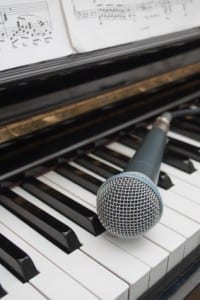How to Record Real Piano
Recording piano is known around engineering circles as one of the most difficult instruments to record and mix. For starters, there is an extremely wide scope of pitches, more than nearly any other single instrument you’ll need to record. And the instrument produces an even wider range of frequencies, ranging from the very low to well beyond the audible spectrum. In addition to that, you have sound going in all directions inside the case of the piano, which can lead to phase issues and other problems.
And these issues are just the beginning. While you could write a book on piano recording techniques, we wanted to provide a beginners guide to the instrument, serving as a way for home recording engineers lucky enough to have a real acoustic piano to begin recording the instrument.
Use Condenser or Ribbon Microphones

Because of all the sonic issues listed above, in almost all piano recording cases you will be best served to use a condenser mic or a ribbon mic. Both of these models are more sensitive to the intricate sounds of the piano, and pick up a wider variety of frequency.
Dynamic mics will focus on the direction they are pointing, and therefore can miss much of the nuance present in the piano. These nuances which include everything from air movement to “phantom” notes are the primary advantages of recording a real piano over a keyboard sample, and will be recorded much better with the more sensitive ribbon and condenser microphones.
Record in Stereo
Nearly all piano tracks will be recorded in stereo. Again, the wide variety of pitches in the instrument offers a great chance to spread the instrument out in your mix. Typically this is done with two mono tracks, one recording the bass frequencies and another taking on the higher frequencies. The EQ on each can be subtly adjusted to what works best with each set of frequencies. However, it should be noted that you won’t want to do too much separate editing to each track, or you can end up with what sounds like two separate instruments.
Another approach to recording is using the Blumlein Pair method, which places two bi-directional microphones at right angles to each other to record a stereo field. We’ll document this setup more thoroughly in a separate article, but the method can be a great way to capture a great sounding piano track, as well as the ambient noise inside the case of the piano without as many phase problems. This will also provide one of the most natural sounding piano sounds when set up correctly.
Best Mic Position For a Piano
The secret to recording piano is that there is no best mic positioning. Every piano even two of the same make and model will produce a different sound and have a different “sweet spot” for mic placement. The best way to determine the best spots is simply by using your ears. Walk around the piano and determine where the sound is best for the type of track that you are recording.
Many times, this means putting the microphones inside the open case of a grand piano. However, sometimes this can produce unwanted sounds, such as feeling too “close” or picking up too much of the sound of the hammers hitting the strings.
Some pianos, then, are best miked from near where the player is seated, since this often offers a more balanced stereo field. Problems with this miking position are from sounds made by the player as well as other unwanted room noise.
Finally, as with just about every recording tip, the best tip is to trust your ears and try different piano recording configurations until you get it right. Only have dynamic mics? Set them up -- it is reported that a favorite recording technique for Beatles’ tracks were a pair of dynamic mics. Fortunately, there’s never a wrong way to do it as long as you get the sounds you are looking for.




